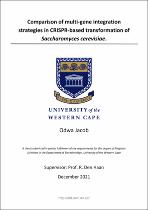| dc.contributor.advisor | den Haan, Riaan | |
| dc.contributor.author | Jacob, Odwa | |
| dc.date.accessioned | 2022-03-24T09:44:45Z | |
| dc.date.available | 2022-03-24T09:44:45Z | |
| dc.date.issued | 2021 | |
| dc.identifier.uri | http://hdl.handle.net/11394/8978 | |
| dc.description | >Magister Scientiae - MSc | en_US |
| dc.description.abstract | Saccharomyces cerevisiae is an important host in industrial biotechnology. This yeast is the host of choice for the first and second-generation biofuels for ethanol production. Genome modification in S. cerevisiae has been extremely successful largely due to this yeast’s highly efficient homology-directed DNA repair machinery. The advent of CRISPR (Clustered Regularly Interspaced Short Palindromic Repeats) genome editing technology has made multi-gene editing in yeast more accessible. In this study, we aimed at targeting the Cas9 to multiple genomic positions for integrating multiple genes at different sites. We have developed two CRISPR-Cas9 systems, based on published one- and two-plasmid systems, for application in S. cerevisiae strains. In this study, these CRISPR-Cas9 systems were used to transform fungal heterologous genes into yeast using the electroporation transformation method. | en_US |
| dc.language.iso | en | en_US |
| dc.publisher | University of Western Cape | en_US |
| dc.subject | Industrial biotechnology | en_US |
| dc.subject | Yeast | en_US |
| dc.subject | CRISPR-Cas9 systems | en_US |
| dc.subject | T.r.eg2 gene | en_US |
| dc.subject | Saccharomyces cerevisiae | en_US |
| dc.title | Comparison of multi-gene integration strategies in CRISPR-based transformation of Saccharomyces cerevisiae | en_US |
| dc.rights.holder | University of Western Cape | en_US |

